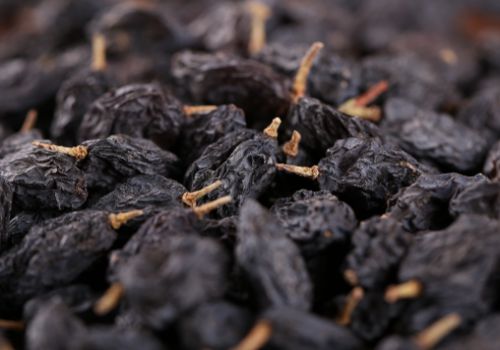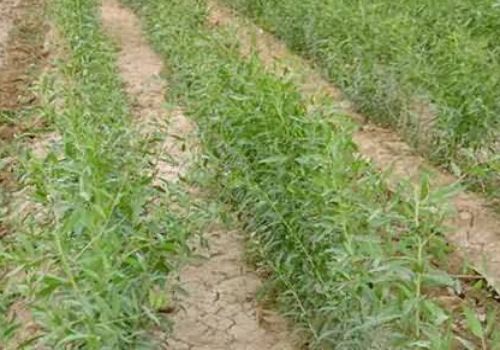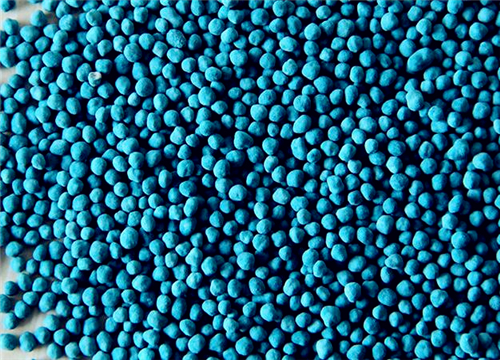Introduction to the planting method of "Natural Nourishing Jiapin" black wolfberry!
Black Chinese wolfberry, also known as sweet Chinese wolfberry, is a kind of natural nourishing product found in recent years. It is becoming more and more popular because of its high medicinal value, nourishing liver and kidney and nourishing essence and eyesight. The price is relatively high, and many growers also want to grow it. So the editor will introduce the planting method of black Chinese wolfberry to you.

I. selection of land and land preparation
The planting environment of black wolfberry needs sufficient light first, so the orchard should be built in a place where the terrain is relatively flat, there is enough sun, the soil is fertile and loose, and it is easy to irrigate, and it is best to build a protective forest. mainly in order to facilitate the black Chinese wolfberry management, fertilization and irrigation farming, the orchard should carry out deep ploughing and turning the soil to mix the base fertilizer before planting, and it is the most suitable to start in the autumn of the year before planting. Because this is conducive to the growth and development of newly planted black wolfberry to improve the survival rate, and then make a good width of at least 1 meter of the field bed to facilitate later management.
II. Methods of reproduction
There are three propagation methods of black wolfberry: sowing, ramet and stem cutting. the sowing is usually carried out before and after the Beginning of Spring in spring, and the seedlings will begin to hold a meeting and bear fruit within 3 years. Ramet propagation is mainly carried out when the old plants begin to sprout in spring. Ramet propagation is relatively simple among the three propagation methods, and stem insertion propagation is usually carried out in April and October. Before breeding, choose a good shoot that grew last year or a branch with full flower buds, cut it into cuttings about 12cm, then insert them into water according to the row spacing of 20*15cm, and compacted and watered them out.
III. Field management
The work of weeding black wolfberry should be carried out in time. The purpose of mid-ploughing is to plough the soil once to enhance soil permeability and prevent soil overcrowding from affecting the respiration of the roots, but be careful not to hurt the roots during ploughing. Weeding is to prevent some weeds from competing with black wolfberry for essential substances such as nutrients, moisture and sunlight, and can also enhance ventilation and permeability in the field. Urea should be used as the main fertilizer at least three times in the seedling stage, and phosphate-plated compound fertilizer should be applied twice after flowering and fruiting. It is necessary to pay attention to the wetness in the orchard. Black wolfberry should not grow in a humid environment and pay attention to drainage.
IV. Harvesting and processing
The annual harvest time of black wolfberry is the most suitable around June in summer. When the black wolfberry is red and the pedicel is loose and there is a tendency to drop the fruit, it can be harvested, but it needs to be picked gently during harvest. Too much force will lead to the rupture and loss of value of the fruit. Flatten out the fruit in time and try not to pile up the fruit. The thickness should not exceed 1 cm. After being flattened, let the sun evaporate the water to turn it into dried fruit, do not turn it.
Summary: the above is about the introduction of black Chinese wolfberry planting methods, growers can refer to the above black Chinese wolfberry planting methods to plant, hoping to help friends in need!
How to grow Chinese wolfberry? Planting method of potted Lycium barbarum
Chinese wolfberry is rich in carotene, which is a very nutritious food. Chinese wolfberry for stewing and soaking in water is very good for the body, so whether it is possible to grow Chinese wolfberry at home? today, the editor will talk about how to grow Chinese wolfberry in a pot at home.
Culture environment
Chinese wolfberry like the sunny environment, indoor potted Chinese wolfberry, can choose a sunny place to maintain, Chinese wolfberry soil requirements are not high, with good drainage calcareous sandy soil is better, avoid clayey and stagnant soil.
How to water
Chinese wolfberry watering is appropriate to see dry watering, summer high-temperature dormancy period, plant growth stagnation, most of the leaves fall off, should be controlled watering, Chinese wolfberry drought-resistant and wet do not accumulate water.
Fertilization method
Usually, liquid fertilizer based on phosphorus and potassium fertilizer is applied about once a week, rotten base fertilizer is applied in winter, and nitrogen fertilizer is applied 2-3 times in full bloom. When turning the basin every year, sufficient base fertilizer should be applied, and phosphate and potassium fertilizers such as calcium superphosphate should be added as base fertilizer.
Bonsai making
Lycium barbarum bonsai modeling is mainly coarse tie, fine cut, tree trunk can be tied into a variety of forms, branches are tied into sheet shape, disk shape. The wire is used for climbing and loosening when the line is trapped. at this time, if the trunk is not fixed, you can climb again. Generally, it can be shaped by climbing for 1 year. Climbing and ligation is often carried out before sprouting or semi-Lignification of budding branches. Pruning is often used to keep the tree shape when forming. When the growth is exuberant, the long branches can be cut off at any time to ensure sufficient buckwheat production. Picking leaves in summer and early autumn, and applying sparse liquid fertilizer containing phosphorus and potassium several times to make flower buds and new leaves grow at the same time, flowering and fruiting accompanied by new leaves are beneficial to ornamental.
Reproduction method
The propagation of Lycium barbarum is mainly by cutting and ramet, and it is simple and easy. Cutting can be carried out in spring and autumn, choose overgrown strong branches or robust vegetative branches, cut into 12-15 cm long, the upper end is cut into a flat mouth, the base is Malta-shaped, and the general seedling rate can reach 80% more than 90%. The method of plant division usually peels off the root buds and transplants them in early spring, properly watering enough water, the seedling rate is very high, or sowing method can be used, banquet seedlings can blossom and bear fruit in 2 or 3 years. The above is the first agricultural scripture editor to sort out the method of potted Chinese wolfberry planting at home, hurry up and try it.
Efficacy and planting methods of Lycium barbarum
How to grow Chinese wolfberry? Chinese wolfberry is one of the medicines we often use to make stew, which has good economic value and nourishing medicinal use. the following is about the efficacy and planting technology of Chinese wolfberry.
First, the efficacy of Chinese wolfberry
Chinese wolfberry is an important economic plant and a good product for both medicine and food. There are 7 species of Lycium barbarum, Lycium barbarum and Lycium barbarum. Among them, there are three kinds of traditional medicinal value, namely, Huangguo Lycium barbarum (Ningxia Lycium barbarum var.), northern Lycium barbarum (Lycium barbarum var.) and Lycium barbarum L. (* Lycium barbarum var.).
The tender leaves of Chinese wolfberry can be used as vegetables; the fruit is sweet and edible and can be processed into health drinks and food. Fruit, leaf, root and bark are all available for medicinal use. Chinese wolfberry fruit has the effect of nourishing kidney, regulating lung, tonifying liver and eyesight, mainly treating yin deficiency of liver and kidney, sore waist and knees, dizziness, dizziness, fatigue cough and spermatorrhea. Lycium barbarum leaves have the effects of tonifying deficiency and essence, clearing heat, relieving thirst, dispelling wind and eyesight, mainly treating fatigue and fever, irritation and thirst, eye pain, heat sore and swelling. Chinese wolfberry root bark (ground bone bark) has the effects of clearing heat, reducing fever, cooling blood and lowering blood pressure. it is mainly for the treatment of deficiency, fatigue, hot sweats, lung heat, cough and asthma, cold blood, hypertension and acne.
II. Methods of reproduction
1. Direct broadcast afforestation. Strip sowing or hole sowing, sowing after soil thawing in late March to April in spring. The sowing depth is 1cm to 3cm. Lycium barbarum is easy to be eaten and uprooted by livestock at the seedling stage and must be banned from grazing.
two。 Raise seedlings and transplant. It is best to raise seedlings in spring and autumn.
3. Cuttings and striping. The root sprouting power of Chinese wolfberry is very strong. After soaking the branches of Chinese wolfberry growing on the barren slope for 2 days, the cuttings with a diameter of 0.5 cm and a length of 30 cm can be cut.
4. Tillers reproduce. Cut off the trunk above the main rhizome of the 2-year-old Chinese wolfberry, and many young branches can sprout in the second year. The main root of Lycium barbarum can also be truncated and propagated through many young branches germinating at both ends of the truncated main root. Spring is the best time to cut off roots.
III. Cultivation and management
1. Cultivation density. The plant spacing is 1.5m in barren soil and 2m in fertile land.
two。 Soil and water and fertilizer management. At the initial fruiting stage, 2 ~ 5 years after planting, the main root of Lycium barbarum was truncated, which was beneficial to the germination of new branches. Chinese wolfberry should be fertilized twice a year, and the fertilization time should be from defoliation to pre-germination, topdressing during flowering and fruit setting, and irrigation after fertilization.
3. Plastic surgery, pruning. Lycium barbarum entered the full fruit period from the fifth year. All the branches were cut short in the same year, and 4-5 well-developed buds were left on each branch, and the lateral branches and extended branches were thinned and cut in the second and third year, so that the branches developed sturdy, uniform density, good ventilation and light transmission.
Pruning principle:
① culture and maintain the plant cluster has 15 to 20 backbone branches, maintain good light conditions, cut off the dense branches.
② cut off the full length of the basal branch and cultured it into the backbone branch, and cut off the tip 3 buds and 5 buds according to the growth strength of the elongated branch and the new shoot.
In order to cultivate long-lived and strong backbone branches, ③ must control the basal branches, so the basal buds should be erased during pruning, leaving only the buds intended for renewal.
④ should remove the branches with insect pests, injuries or too weak as soon as possible, and leave new branches to replenish them.
IV. Harvesting and processing
1. Harvest and processing of Chinese wolfberry fruit. The harvest of Chinese wolfberry is between Grain in Beard and the Autumn Equinox. Pick ripe fruit, dry or dry in the shade. Be careful not to rub it with your hands so as not to affect the quality. When the skin is dry and the pulp is soft, it can be dried by fire when it is rainy.
two。 The planing of the skin of the earth. When the Beginning of Spring is unfrozen, the quality is good and easy to peel, but the quality of the bone skin is poor after the Qingming Festival. Peel off the root bark and dry it or cut it up while it is fresh.
- Prev

Introduction to the planting method of "Mingyanzi" Chinese wolfberry!
Chinese wolfberry is a kind of healthy traditional Chinese medicine, which is very common in our daily life. Because of its high nutritional value and clear-sighted effect, it is welcomed by many people and is in great demand in the market. many growers also want to plant
- Next

How much is the price of Dichondra seeds per jin? Detailed introduction of planting methods!
If we say Dichondra repens, many people do not know what it is, but when it comes to small money grass, many people will say that it is it. Yes, Dichondra, also known as Dichondra, is a kind of herbal medicine often used to treat hepatitis. So how much is the seed price of Dichondra repens now?
Related
- Fuxing push coffee new agricultural production and marketing class: lack of small-scale processing plants
- Jujube rice field leisure farm deep ploughing Yilan for five years to create a space for organic food and play
- Nongyu Farm-A trial of organic papaya for brave women with advanced technology
- Four points for attention in the prevention and control of diseases and insect pests of edible fungi
- How to add nutrient solution to Edible Fungi
- Is there any good way to control edible fungus mites?
- Open Inoculation Technology of Edible Fungi
- Is there any clever way to use fertilizer for edible fungus in winter?
- What agents are used to kill the pathogens of edible fungi in the mushroom shed?
- Rapid drying of Edible Fungi

